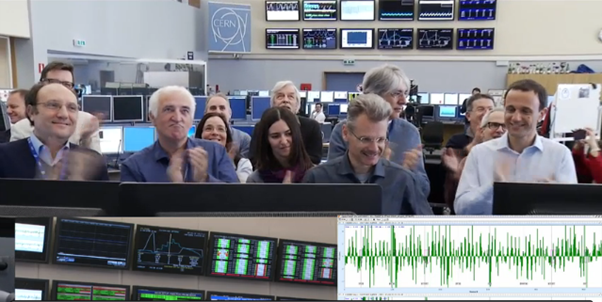 The LHC is back in business
The LHC is back in business
by Margarita Synanidi (CERN), Agnes Szeberenyi (CERN)

Reactions in the CERN control centre on the 5th of April
Image credit: CERN
After two years of crucial upgrade work, the world’s largest and most powerful atom smasher is back in operation. On the 5th April, at 10.41am, a proton beam was back in the 27-kilometer ring, followed at 12.27pm by a second beam rotating in the opposite direction. These beams circulated at their injection energy of 450 GeV. The Director General of CERN mentioned “the beam went smoothly through the whole machine. It’s fantastic to see it going so well after two years and such a major overhaul of the LHC”. On 9th April the operations team successfully circulated a beam at 6.5 TeV.
Start-up was delayed for two weeks after a piece of metal caused a short circuit in the safety system around one of the LHC’s superconducting magnets. Engineers cleared the debris on 30 March by vaporizing it with a discharge of current. A similar problem occurred before, at the start of the LHC’s first run, and it was also solved without causing major delays.
On Sunday the protons injected at a relatively low energy to begin with. They will keep working nonstop 24hours per day until they will establish the first stable collision, as explained by the LHC coordinator of operation, Jorg Wenninger.
Over the coming months, engineers hope to gradually increase the beams' energy to 13 trillion electronvolts (double speed what it was during first operating run). They scientists estimate that the particle collisions at an energy of 13 TeV could start as early as June. With that beam energy level raised, it is conceivable that the LHC will capture dark matter, marking a leap forward in our understanding of the universe.
Now starts a new phase of the study of physics, it remains to be seen what the results will be.
Read more >>
